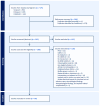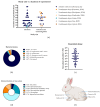Prosthetic Joint Infection Research Models in NZW Rabbits: Opportunities for Standardization-A Systematic Review
- PMID: 39452605
- PMCID: PMC11508679
- DOI: 10.3390/jfb15100307
Prosthetic Joint Infection Research Models in NZW Rabbits: Opportunities for Standardization-A Systematic Review
Abstract
Prosthetic joint infection (PJI) is a major complication following total arthroplasty. Rising antimicrobial resistance (AMR) to antibiotics will further increase therapeutic insufficiency. New antibacterial technologies are being developed to prevent PJI. In vivo models are still needed to bridge the translational gap to clinical implementation. Though rabbit models have been used most frequently, there is no consensus about methodology and measured outcomes. The PubMed, Scopus, and EMBASE databases were searched for literature on PJI in rabbit models. Data extraction included bias control, experimental design, and outcome measures of the NZW rabbit models in the articles. A total of 60 articles were included in this systematic literature review. The articles were divided into six groups based on the PJI intervention: no intervention used (21%), revision surgery (14%), prevention with only antibiotics (21%), prevention with surface modifications (7%), prevention with coatings (23%), and others (14%). Despite the current availability of guidelines and recommendations regarding experimental design, bias control, and outcome measures, many articles neglect to report on these matters. Ultimately, this analysis aims to assist researchers in determining suitable clinically relevant methodologies and outcome measures for in vivo PJI models using NZW rabbits to test new antimicrobial technologies.
Keywords: ARRIVE guidelines; NZW rabbit; antibacterial technologies; in vivo; prosthetic joint infection.
Conflict of interest statement
The authors declare no conflicts of interest. The funding agencies had no role in the design of the study.
Figures





Similar articles
-
Treatment patterns and failure rates associated with prosthetic joint infection in unicompartmental knee arthroplasty: A systematic review.J Orthop. 2022 Sep 14;34:288-294. doi: 10.1016/j.jor.2022.09.008. eCollection 2022 Nov-Dec. J Orthop. 2022. PMID: 36158037 Free PMC article. Review.
-
Antibiotic containing bone cement in prevention of hip and knee prosthetic joint infections: A systematic review and meta-analysis.J Orthop Translat. 2020 May 8;23:53-60. doi: 10.1016/j.jot.2020.04.005. eCollection 2020 Jul. J Orthop Translat. 2020. PMID: 32489860 Free PMC article. Review.
-
Periprosthetic Joint Infection Following Clean Hand Surgery: A Systematic Review.J Hand Surg Glob Online. 2022 Apr 15;4(4):208-213. doi: 10.1016/j.jhsg.2022.03.003. eCollection 2022 Jul. J Hand Surg Glob Online. 2022. PMID: 35880154 Free PMC article.
-
The Role of Long-Term Antibiotic Suppression in the Management of Peri-Prosthetic Joint Infections Treated With Debridement, Antibiotics, and Implant Retention: A Systematic Review.J Arthroplasty. 2020 Apr;35(4):1154-1160. doi: 10.1016/j.arth.2019.11.026. Epub 2019 Dec 9. J Arthroplasty. 2020. PMID: 31955984
-
Systemic Inflammation Response Index (SIRI) and Monocyte-to-Lymphocyte Ratio (MLR) Are Predictors of Good Outcomes in Surgical Treatment of Periprosthetic Joint Infections of Lower Limbs: A Single-Center Retrospective Analysis.Healthcare (Basel). 2024 Apr 23;12(9):867. doi: 10.3390/healthcare12090867. Healthcare (Basel). 2024. PMID: 38727424 Free PMC article.
References
-
- Klug A., Gramlich Y., Rudert M., Drees P., Hoffmann R., Weissenberger M., Kutzner K.P. The projected volume of primary and revision total knee arthroplasty will place an immense burden on future health care systems over the next 30 years. Knee Surg. Sports Traumatol. Arthrosc. 2021;29:3287–3298. doi: 10.1007/s00167-020-06154-7. - DOI - PMC - PubMed
Publication types
Grants and funding
LinkOut - more resources
Full Text Sources
Molecular Biology Databases
Miscellaneous

